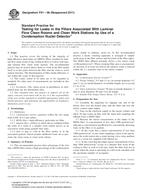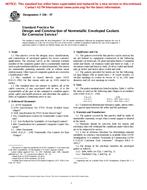1.1 This test method covers the determination of fracture toughness (KIc) of metallic materials under predominantly linear-elastic, plane-strain conditions using fatigue precracked specimens having a thickness of 1.6 mm (0.063 in.) or greater subjected to slowly, or in special (elective) cases rapidly, increasing crack-displacement force. Details of test apparatus, specimen configuration, and experimental procedure are given in the Annexes.
Note 1 – Plane-strain fracture toughness tests of thinner materials that are sufficiently brittle (see 7.1) can be made using other types of specimens (1). There is no standard test method for such thin materials.
1.2 This test method is divided into two parts. The first part gives general recommendations and requirements for KIc testing. The second part consists of Annexes that give specific information on displacement gage and loading fixture design, special requirements for individual specimen configurations, and detailed procedures for fatigue precracking. Additional annexes are provided that give specific procedures for beryllium and rapid-force testing.
1.3 General information and requirements common to all specimen configurations:
| Section | |
|---|---|
| Referenced Documents | 2 |
| Terminology | 3 |
| Stress-Intensity Factor | 3.1.1 |
| Plane-Strain Fracture Toughness | 3.1.2 |
| Crack Plane Orientation | 3.1.3 |
| Summary of Test Method | 4 |
| Significance and Use | 5 |
| Significance | 5.1 |
| Precautions | 5.1.1-5.1.5 |
| Practical Applications | 5.2 |
| Apparatus (see also 1.4) | 6 |
| Tension Machine | 6.1 |
| Fatigue Machine | 6.2 |
| Loading Fixtures | 6.3 |
| Displacement Gage, Measurement | 6.4 |
| Specimen Size, Configurations, and Preparation (see also 1.5) | 7 |
| Specimen Size Estimates | 7.1 |
| Standard and Alternative Specimen Configurations | 7.2 |
| Fatigue Crack Starter Notches | 7.3.1 |
| Fatigue Precracking (see also 1.6) | 7.3.2 |
| Crack Extension Beyond Starter Notch | 7.3.2.2 |
| General Procedure | 8 |
| Specimen Measurements | |
| Thickness | 8.2.1 |
| Width | 8.2.2 |
| Crack Size | 8.2.3 |
| Crack Plane Angle | 8.2.4 |
| Specimen Testing | |
| Loading Rate | 8.3 |
| Test Record | 8.4 |
| Calculation and Interpretation of Results | 9 |
| Test Record Analysis | 9.1 |
| Pmax/PQ Validity Requirement | 9.1.3 |
| Specimen Size Validity Requirements | 9.1.4 |
| Reporting | 11 |
| Precision and Bias | 12 |
1.4 Specific requirements related to test apparatus:
| Double-Cantilever Displacement Gage | Annex A1 |
| Testing Fixtures | Annex A2 |
| Bend Specimen Loading Fixture | Annex A2.1 |
| Compact Specimen Loading Clevis | Annex A2.2 |
1.5 Specific requirements related to individual specimen configurations:
| Bend Specimen SE(B) | Annex A3 |
| Compact Specimen C(T) | Annex A4 |
| Disk-Shaped Compact Specimen DC(T) | Annex A5 |
| Arc-Shaped Tension Specimen A(T) | Annex A6 |
| Arc-Shaped Bend Specimen A(B) | Annex A7 |
1.6 Specific requirements related to special test procedures:
| Fatigue Precracking KIc Specimens | Annex A8 |
| Hot-Pressed Beryllium Testing | Annex A9 |
| Rapid-Force Testing | Annex A10 |
1.7 The values stated in SI units are to be regarded as the standard. The values given in parentheses are for information only.
1.8 This standard does not purport to address all of the safety concerns, if any, associated with its use. It is the responsibility of the user of this standard to establish appropriate safety and health practices and determine the applicability of regulatory limitations prior to use.
Product Details
- Published:
- 11/15/2008
- Number of Pages:
- 33
- File Size:
- 1 file , 690 KB
- Redline File Size:
- 2 files , 1.2 MB


